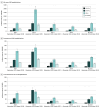All-Cause and Pneumococcal Community-Acquired Pneumonia Hospitalizations Among Adults in Tennessee and Georgia
- PMID: 40768150
- PMCID: PMC12329615
- DOI: 10.1001/jamanetworkopen.2025.24783
All-Cause and Pneumococcal Community-Acquired Pneumonia Hospitalizations Among Adults in Tennessee and Georgia
Abstract
Importance: Although the use of pneumococcal conjugate vaccines (PCV) has reduced the overall burden of pneumococcal disease, recent measurements of pneumococcal pneumonia incidence are lacking.
Objective: To prospectively quantify the burden of pneumococcal pneumonia and to assess the potential impact of the recently approved adult-specific 21-valent pneumococcal conjugate vaccine (V116).
Design, settings, and participants: This cross-sectional study for prospective active surveillance included adults residing in defined catchment areas in Tennessee and Georgia hospitalized with clinical and radiographical evidence of community-acquired pneumonia (CAP) at 3 hospitals between 2018 and 2022. Data were analyzed from July 2024 to January 2025.
Main outcomes and measures: Pneumococcal etiology was determined using an on-market serotype-agnostic urinary antigen test, serotype-specific urinary antigen detection assays covering 30 serotypes, and routine clinical tests. Overall and age-stratified incidence rates for pneumonia hospitalizations were estimated accounting for the probability of enrollment and hospital market share of enrolling hospitals within the catchment area.
Results: Among 2016 patients hospitalized for CAP, the median (IQR) age was 60.1 (47.0-70.2) years; 726 patients (36.0%) were Black, 81 (4.0%) were Hispanic, and 1209 (60.0%) were White; 1863 patients (92.4%) lived in a community dwelling. A total of 279 patients (13.8%) hospitalized for CAP had evidence of pneumococcal pneumonia, and 198 (9.8%) had detection of serotypes included in V116. The overall estimated annual incidence of hospitalizations for all-cause CAP was 340 per 100 000 adults. The incidence of hospitalizations for pneumococcal CAP and pneumococcal CAP due to serotypes included in V116 was 43 and 30 per 100 000 adults, respectively. The burden of all-cause and pneumococcal CAP was consistently highest among adults age 65 years or older.
Conclusions and relevance: This prospective surveillance study demonstrated a large burden of hospitalizations for CAP among US adults, with the highest burden of disease among adults age 65 years or older. A sizable fraction of CAP was caused by Streptococcus pneumoniae, especially by serotypes included in V116.
Conflict of interest statement
Figures


References
-
- GBD 2021 Lower Respiratory Infections and Antimicrobial Resistance Collaborators . Global, regional, and national incidence and mortality burden of non-COVID-19 lower respiratory infections and aetiologies, 1990-2021: a systematic analysis from the Global Burden of Disease Study 2021. Lancet Infect Dis. 2024;24(9):974-1002. doi: 10.1016/S1473-3099(24)00176-2 - DOI - PMC - PubMed
-
- Metlay JP, Waterer GW, Long AC, et al. Diagnosis and treatment of adults with community-acquired pneumonia. an official clinical practice guideline of the American Thoracic Society and Infectious Diseases Society of America. Am J Respir Crit Care Med. 2019;200(7):e45-e67. doi: 10.1164/rccm.201908-1581ST - DOI - PMC - PubMed
MeSH terms
Substances
LinkOut - more resources
Full Text Sources
Miscellaneous

